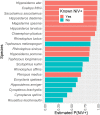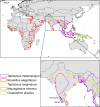Prioritizing surveillance of Nipah virus in India - PubMed (original) (raw)
Prioritizing surveillance of Nipah virus in India
Raina K Plowright et al. PLoS Negl Trop Dis. 2019.
Erratum in
- Correction: Prioritizing surveillance of Nipah virus in India.
Plowright RK, Becker DJ, Crowley DE, Washburne AD, Huang T, Nameer PO, Gurley ES, Han BA. Plowright RK, et al. PLoS Negl Trop Dis. 2023 Feb 10;17(2):e0011126. doi: 10.1371/journal.pntd.0011126. eCollection 2023 Feb. PLoS Negl Trop Dis. 2023. PMID: 36763578 Free PMC article.
Abstract
The 2018 outbreak of Nipah virus in Kerala, India, highlights the need for global surveillance of henipaviruses in bats, which are the reservoir hosts for this and other viruses. Nipah virus, an emerging paramyxovirus in the genus Henipavirus, causes severe disease and stuttering chains of transmission in humans and is considered a potential pandemic threat. In May 2018, an outbreak of Nipah virus began in Kerala, > 1800 km from the sites of previous outbreaks in eastern India in 2001 and 2007. Twenty-three people were infected and 21 people died (16 deaths and 18 cases were laboratory confirmed). Initial surveillance focused on insectivorous bats (Megaderma spasma), whereas follow-up surveys within Kerala found evidence of Nipah virus in fruit bats (Pteropus medius). P. medius is the confirmed host in Bangladesh and is now a confirmed host in India. However, other bat species may also serve as reservoir hosts of henipaviruses. To inform surveillance of Nipah virus in bats, we reviewed and analyzed the published records of Nipah virus surveillance globally. We applied a trait-based machine learning approach to a subset of species that occur in Asia, Australia, and Oceana. In addition to seven species in Kerala that were previously identified as Nipah virus seropositive, we identified at least four bat species that, on the basis of trait similarity with known Nipah virus-seropositive species, have a relatively high likelihood of exposure to Nipah or Nipah-like viruses in India. These machine-learning approaches provide the first step in the sequence of studies required to assess the risk of Nipah virus spillover in India. Nipah virus surveillance not only within Kerala but also elsewhere in India would benefit from a research pipeline that included surveys of known and predicted reservoirs for serological evidence of past infection with Nipah virus (or cross reacting henipaviruses). Serosurveys should then be followed by longitudinal spatial and temporal studies to detect shedding and isolate virus from species with evidence of infection. Ecological studies will then be required to understand the dynamics governing prevalence and shedding in bats and the contacts that could pose a risk to public health.
Conflict of interest statement
The authors have declared that no competing interests exist.
Figures
Fig 1. Global map of Nipah virus sampling effort and detections.
The country-level distribution of whether bats have been sampled for Nipah virus and whether positive detections have occurred using PCR or serology (noting that serological detection likely includes cross-reactions with Nipah-like viruses). Light blue shading shows regions of India where bats have been found positive for Nipah virus (states of Haryana, Maharashtra, West Bengal); studies did not report exact sampling coordinates [40, 41]. Shapefiles were obtained from the maps and mapdata packages in R. The right panels show the number of sampling events and the percentage of positive detections by PCR or serology in each country.
Fig 2. Phylogeny of Indian bats and Nipah virus detections.
Serological detections of Nipah virus are scattered across the bat phylogeny, although sampling coverage across the phylogeny is low (see also Table 1). Note that serological assays for Nipah virus likely cross-react with Nipah-like henipaviruses.
Fig 3. Predicted probability of top 20 Indian bat species being Nipah virus positive.
Nipah virus has been detected in Pteropus medius, but other bat species have either known exposure (serological reactivity to Nipah virus) or predicted exposure based on our analysis of Nipah virus surveys. Red indicates having evidence of Nipah virus exposure or infection (by serology or PCR) and blue indicates no previous evidence of Nipah virus exposure.
Fig 4. Range of predicted bat species.
Geographic ranges of bat species that are in the 90th percentile of similarity (based on generalized boosted regression) with other bat species that are positive for Nipah virus from Asia, Australia, and Oceana (based on PCR or serology). The terrestrial mammal range shapefile was downloaded from the IUCN website (
http://www.iucnredlist.org/technical-documents/spatial-data
) and the figure was created with ArcGIS.
Similar articles
- Nipah virus dynamics in bats and implications for spillover to humans.
Epstein JH, Anthony SJ, Islam A, Kilpatrick AM, Ali Khan S, Balkey MD, Ross N, Smith I, Zambrana-Torrelio C, Tao Y, Islam A, Quan PL, Olival KJ, Khan MSU, Gurley ES, Hossein MJ, Field HE, Fielder MD, Briese T, Rahman M, Broder CC, Crameri G, Wang LF, Luby SP, Lipkin WI, Daszak P. Epstein JH, et al. Proc Natl Acad Sci U S A. 2020 Nov 17;117(46):29190-29201. doi: 10.1073/pnas.2000429117. Epub 2020 Nov 2. Proc Natl Acad Sci U S A. 2020. PMID: 33139552 Free PMC article. - Nipah Virus Sequences from Humans and Bats during Nipah Outbreak, Kerala, India, 2018.
Yadav PD, Shete AM, Kumar GA, Sarkale P, Sahay RR, Radhakrishnan C, Lakra R, Pardeshi P, Gupta N, Gangakhedkar RR, Rajendran VR, Sadanandan R, Mourya DT. Yadav PD, et al. Emerg Infect Dis. 2019 May;25(5):1003-1006. doi: 10.3201/eid2505.181076. Emerg Infect Dis. 2019. PMID: 31002049 Free PMC article. - Emerging trends of Nipah virus: A review.
Sharma V, Kaushik S, Kumar R, Yadav JP, Kaushik S. Sharma V, et al. Rev Med Virol. 2019 Jan;29(1):e2010. doi: 10.1002/rmv.2010. Epub 2018 Sep 24. Rev Med Virol. 2019. PMID: 30251294 Free PMC article. Review. - Henipaviruses: an updated review focusing on the pteropid reservoir and features of transmission.
Clayton BA, Wang LF, Marsh GA. Clayton BA, et al. Zoonoses Public Health. 2013 Feb;60(1):69-83. doi: 10.1111/j.1863-2378.2012.01501.x. Epub 2012 Jun 18. Zoonoses Public Health. 2013. PMID: 22709528 Review. - The pandemic potential of Nipah virus.
Luby SP. Luby SP. Antiviral Res. 2013 Oct;100(1):38-43. doi: 10.1016/j.antiviral.2013.07.011. Epub 2013 Jul 30. Antiviral Res. 2013. PMID: 23911335
Cited by
- Sampling to elucidate the dynamics of infections in reservoir hosts.
Plowright RK, Becker DJ, McCallum H, Manlove KR. Plowright RK, et al. Philos Trans R Soc Lond B Biol Sci. 2019 Sep 30;374(1782):20180336. doi: 10.1098/rstb.2018.0336. Epub 2019 Aug 12. Philos Trans R Soc Lond B Biol Sci. 2019. PMID: 31401966 Free PMC article. Review. - An emerging zoonotic disease to be concerned about - a review of the nipah virus.
Paliwal S, Shinu S, Saha R. Paliwal S, et al. J Health Popul Nutr. 2024 Oct 28;43(1):171. doi: 10.1186/s41043-024-00666-5. J Health Popul Nutr. 2024. PMID: 39468679 Free PMC article. Review. - From Protein to Pandemic: The Transdisciplinary Approach Needed to Prevent Spillover and the Next Pandemic.
Plowright RK, Hudson PJ. Plowright RK, et al. Viruses. 2021 Jul 2;13(7):1298. doi: 10.3390/v13071298. Viruses. 2021. PMID: 34372504 Free PMC article. Review. - Identifying life-history patterns along the fast-slow continuum of mammalian viral carriers.
Tonelli A, Caceres-Escobar H, Blagrove MSC, Wardeh M, Di Marco M. Tonelli A, et al. R Soc Open Sci. 2024 Jul 24;11(7):231512. doi: 10.1098/rsos.231512. eCollection 2024 Jul. R Soc Open Sci. 2024. PMID: 39050720 Free PMC article. - Using serosurveys to optimize surveillance for zoonotic pathogens.
Clancey E, Nuismer SL, Seifert SN. Clancey E, et al. bioRxiv [Preprint]. 2024 Oct 4:2024.02.22.581274. doi: 10.1101/2024.02.22.581274. bioRxiv. 2024. PMID: 38562792 Free PMC article. Preprint.
References
- Organization WH. Blueprint for R&D preparedness and response to public health emergencies due to highly infectious pathogens. Workshop on Prioritization of Pathogens. 2015, December.
- Chua KB, Goh KJ, Wong KT, Kamarulzaman A, Tan PSK, Ksiazek TG, et al. Fatal encephalitis due to Nipah virus among pig-farmers in Malaysia. The Lancet. 1999;354:1256–59. - PubMed
- Harit A, Ichhpujani R, Gupta S, Gill K. Nipah/Hendra virus outbreak in Siliguri, West Bengal, India in 2001. Indian Journal of Medical Research. 2006;123(4):553 - PubMed
Publication types
MeSH terms
LinkOut - more resources
Full Text Sources
Other Literature Sources
Medical
Miscellaneous



